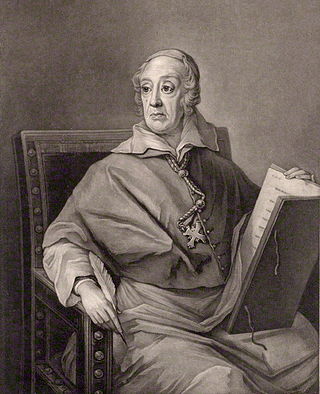Related Research Articles
Thomas Knaggs was a preacher and publisher of sermons.
Thomas II was a medieval archbishop of York.

White Kennett was an English bishop and antiquarian. He was educated at Westminster School and at St Edmund Hall, Oxford, where, while an undergraduate, he published several translations of Latin works, including Erasmus' In Praise of Folly.
Thomas Grant (1816–1870) was a Roman Catholic bishop. He was born in France to British parents in the years following the defeat of the French at Waterloo. He became known as a great negotiator as the Roman Catholic hierarchy was rebuilt in the United Kingdom. He died of cancer while in Rome to attend the first Vatican Council.
Thomas Worthington, D.D. was an English Catholic priest and third President of Douai College.
William Bishop was the first Roman Catholic bishop in England after the Reformation, serving as Vicar Apostolic of England and titular Bishop of Chalcedon.

Bonaventure Giffard (1642–1734) was a Roman Catholic bishop who served as the Vicar Apostolic of the Midland District of England from 1687 to 1703 and Vicar Apostolic of the London District of England from 1703 to 1734.

The Venerable English College, commonly referred to as the English College, is a Catholic seminary in Rome, Italy, for the training of priests for England and Wales. It was founded in 1579 by William Allen on the model of the English College, Douai.

Philip Bisse was an English bishop.
Richard Smith, . Having studied at the English College in Rome, he taught at Valladolid and Seville. He succeeded William Bishop, as the second Catholic Vicar apostolic for England, Wales and Scotland.
The Archpriest Controversy was the debate which followed the appointment of an archpriest by Pope Clement VIII to oversee the efforts of the Roman Catholic Church's missionary priests in England at the end of the sixteenth century.
Daniel Fitter was an English Catholic clergyman who was affected by but managed to navigate his way through the religious strife of the late seventeenth century.
John Betham (1642?–1709) was an English Catholic priest and tutor to James Francis Edward Stuart.

William Bates (1625–1699) was an English Presbyterian minister.

John Kettlewell was an English clergyman, nonjuror and devotional writer. He is now known for his arguments against William Sherlock, who had justified the change of monarch of 1688–89 and his own switch of sides in The Case of the Allegiance. According to J. P. Kenyon, Kettlewell's reply made a case "with which conformist Anglicans could only agree, because it was spiritual, while Sherlock's was resolutely aspiritual". He went on to attack defenders of the Glorious Revolution generally as proponents of fallacious contractarian theories.

Samuel Cooper was a Congregational minister in Boston, Massachusetts, affiliated with the Brattle Street Church. He was born in Boston to William Cooper and Judith Sewall, attended the Boston Latin School, and was graduated from Harvard College in 1743. He was ordained as a minister on May 21, 1746, and served as pastor of the Brattle Street Church, 1747-1783. Members of his parish at the Brattle St. Church included some of the most influential people of the American Revolution: John Hancock, Samuel Adams, Joseph Warren, John Adams, and others. He corresponded with Benjamin Franklin, Charles Hector d'Estaing, Gideon Hawley, Charles Gravier de Vergennes; and was associated with Phillis Wheatley. In 1780, he co-founded the American Academy of Arts and Sciences. He served as "chaplain to the General Court" 1758-1770 and 1777-1783. Around 1783 Harvard College offered Cooper the position of college president, but Cooper declined. In September 1746 he married Judith Bulfinch; they had two daughters. A portrait of Cooper by John Singleton Copley now resides in the collection of the Massachusetts Historical Society.
Peter Gooden was an English Roman Catholic priest, who came to prominence as a controversialist during the reign of James II.

The Oath of Allegiance of 1606 was an oath requiring English Catholics to swear allegiance to James I over the Pope. It was adopted by Parliament the year after the Gunpowder Plot of 1605. The oath was proclaimed law on 22 June 1606, it was also called the Oath of Obedience. Whatever effect it had on the loyalty of his subjects, it caused an international controversy lasting a decade and more.
Edmund Bateman (1704–1751) was an English cleric and academic, the Archdeacon of Lewes from 1737 until 1751.
Ralph Lambert (1667–1731) was an Irish Anglican priest in the first half of the 18th century.
References
- 1 2 3 4 Burton 1913.
- ↑ Cooper 1887.
- Attribution
 This article incorporates text from a publication now in the public domain : Burton, Edwin Hubert (1913). "Thomas Codrington". In Herbermann, Charles (ed.). Catholic Encyclopedia . New York: Robert Appleton Company.
This article incorporates text from a publication now in the public domain : Burton, Edwin Hubert (1913). "Thomas Codrington". In Herbermann, Charles (ed.). Catholic Encyclopedia . New York: Robert Appleton Company. This article incorporates text from a publication now in the public domain : Cooper, Thompson (1887). "Codrington, Thomas". In Stephen, Leslie (ed.). Dictionary of National Biography . Vol. 11. London: Smith, Elder & Co. p. 210.
This article incorporates text from a publication now in the public domain : Cooper, Thompson (1887). "Codrington, Thomas". In Stephen, Leslie (ed.). Dictionary of National Biography . Vol. 11. London: Smith, Elder & Co. p. 210.